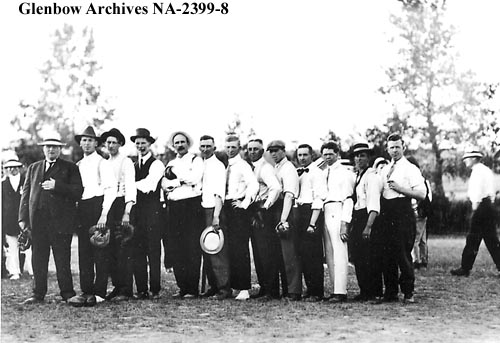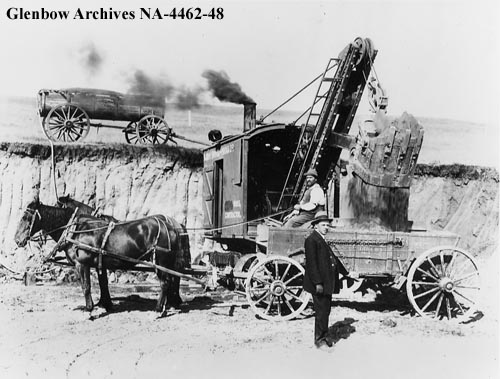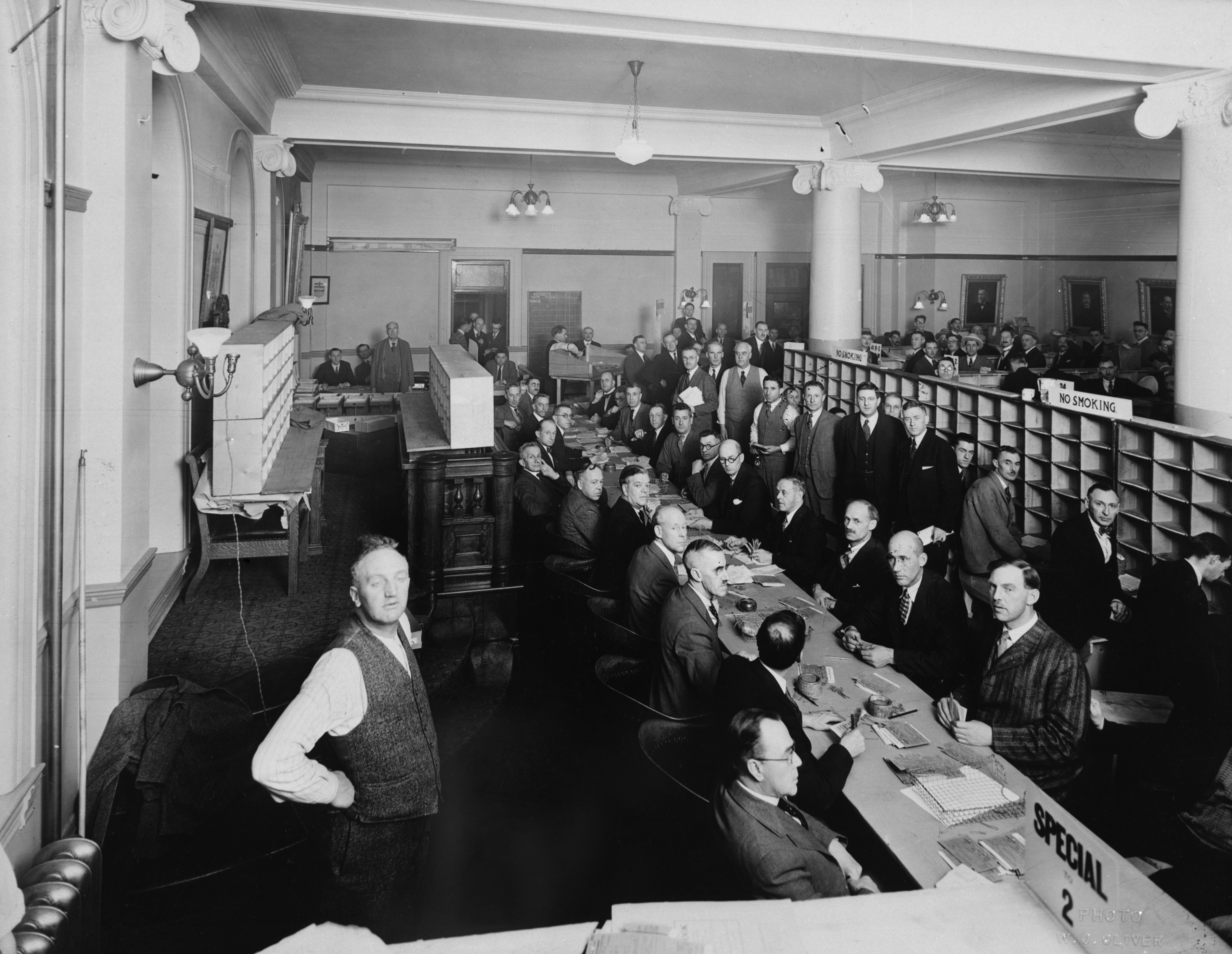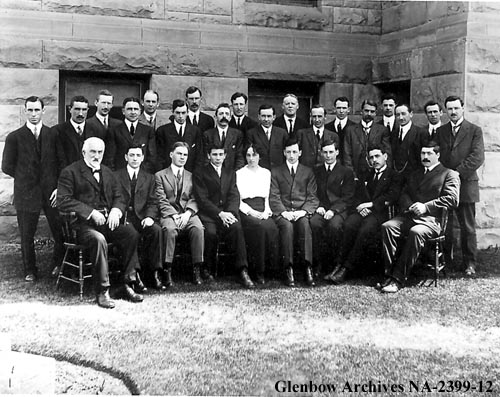Calgary's First Employees

In 1910, the Calgary Daily Herald published a short series of page-one profiles on civic officials, all of whom still worked for The City of Calgary when the newly built City Hall opened the following year.
The profiles featured only a small number of City staff who went on to serve the public for decades.
Enjoy these employee profiles, most of which are direct quotes from the original profiles published in May 1910.
May 3, 1910
William Henry Rowbotham Gardiner (1881-1937)
Superintendent of streets in the Public Works Department from 1910 to 1935
William Gardiner was born in Doncaster, Yorkshire, England and immigrated to Canada with his parents when he was seven. As his profile in the Calgary Daily Herald said:
“For a number of years he spent his life as a rancher and farmer. The lures of a more strenuous life, however, called him to the city and to the benefit of Calgary he entered the service of the public works department and will likely stay there another five years if he so wishes.
“In a growing and progressive city such as Calgary, there must, of necessity, be much hard work and long hours on the part of the executive officials who have charge of the various working departments of the city.
“He is on the job every day from early until late and knows the city better and sees more of it every day than any other person who resides here. And his duties are many and varied. He is the man who looks after and attends to all the street grading, sees that repairs are made to all defective street crossings and defective sidewalks, keeps his eyes open for spots dangerous to pedestrians and street traffic, and has general supervision over the many bridges, etc., in the city and suburbs. And he knows his business, too. His five years experience in his present position has resulted in furnishing Calgary with a competent street superintendent who has the confidence and approval of the commissioners and others with whom he works.”
According to the Find a Grave website, Gardiner was a curler and served as president of the Alberta branch of the Royal Caledonian Curling Association. He was a director on the Calgary Stampede Association and a member of the Independent Order of Odd Fellows, a fraternal and charitable organization.

May 4, 1910
Thomas Mackie
Chief of Police
Thomas Mackie’s Who’s Who column began: “Thomas Mackie, the man who is at the head of the force which looks after and takes charge of transgressors and violators against the criminal code of the city, province and dominion, is, as his name will imply, a native of the land of the thistle and oatmeal.”
Mackie was born Sept. 29, 1865 in Elton, Aberdeenshire, Scotland. He “plowed the heather as a farmer” until he was 23. He joined the Greenock police force as a constable in 1889 and became a sergeant in 1895. He took two classes in First Aid to the Injured in the St. Andrew's Ambulance association. He left Scotland in 1903 to be a northwest farmer.
“He headed for Calgary, but on reaching here, the ‘back to the land’ idea was entirely forgotten and the blue uniform and sliver buttons again looked good to him. He joined the Calgary police force in July 1903, again received a sergeant's stripes for the second time in July 1906 and on the last day of August was appointed to the honored position of chief of police of the best and largest city of the vast prairie west.”
According to the List of 150 Alberta Historical People, Mackie earned $150 a month, worked 10 hours a day and had one day off a week. He was seen as a fair and honest man and became known as “honest” Tom Mackie. As police chief, “He acquired horses to form a mounted patrol, he created a specialized detective department and he introduced a motorized paddy wagon, known as the ‘Black Maria’ to take the culprits away.” His granddaughter, Lois Mitchell, was the 18th Lieutenant Governor of Alberta.
May 5, 1910
William Mills (1873-1936)
Police inspector
William Mills’ Who’s Who article said he was born in “the northernmost part of Scotland” in November 1873. At age 22, he was accepted as a constable on the Edinburgh police force. He patrolled the “streets and thoroughfares” for five years then immigrated to Canada. He found work on the Winnipeg police force in 1900. The article said, “Three years in that city was enough for him, and he came to Calgary, liked the place, made it his home, and intends to remain here.”
He was hired by the Calgary police force in 1904, became a sergeant in April 1907 then inspector on May 1, which made him second in command to the chief.
The article said, “’Big Bill’ Mills has thousands of friends in Calgary and throughout the west, who were glad to hear of the new honors thrust upon him. He has the confidence of all the men under him and knows all there is to know about the police and detective business. Although a strict disciplinarian, he avoids rather than looks for trouble, and hundreds of family and other troubles have been amicably settled out of court by the warring parties shaking hands and getting together after a few minutes consultation with the genial dispositioned inspector.”
”He is the largest man on the force, standing six feet, two inches and weighs, when in fighting condition, 230 pounds. His big, warm, kind heart stretches through every sinew and bone of this large frame, as many a poor unfortunate who has been obliged to spend time in jail under his charge will readily testify.”
Mills later in life managed the King Edward Hotel and the National Hotel.

May 6, 1910
John Russell Elliott (1880–1950)
Timekeeper in the city comptroller’s office
John Elliott was born in April 1880 in Wingham, Huron Co., Ont. “After leaving school, he was employed in the hardware business both as a store and road salesman for a few years. Twelve years ago he came west to Winnipeg where he remained for two years. Then it was on to Calgary and an inspection of the rapidly growing city, made a decision that it was ‘It for Mine,’ now henceforth and for evermore.”
Elliott started at The City in April 1903 as a roadman. “Strict attention to his duties resulted in rapid promotions and after being grading foreman, transit man, etc. he was appointed chief clerk to the city engineer.” In this position, he kept “in detail, books which will at a moments notice show the costs of and funds expended on all local improvements and public work being installed under money bylaws favorably voted upon by the ratepayers.”
"Mr. Russell likes the rural life and before and after business hours he enjoys nothing better than cultivating his five-acre farm just north of the Bow in the northeast district of the city limits -- that is if he is not angling for the aristocrat of the finny tribe, namely the trout.”
May 10, 1910
William Nutt
Detective-Sergeant
William Nutt, born in Londonderry, Ireland, in 1877, joined the Royal Irish Constabulary when he was 21. He remained there “for six long, hard years,” his Who’s Who column said. He moved to Canada in 1904 “and at once made for the then wild and woolly west and made Calgary his headquarters. For two years he went back to his old love, that of farming, working for farmers and ranchers in this vicinity.
“In March 1906, ex-Chief English placed him on the Calgary police force and two years later made him a ‘plain clothes’ man. He acted in that capacity until September of last year when Chief Mackie named him a detective-Sergeant, a position which made him head of the sleuth department of the city.
“The profession of catching a thief, crook or other lawbreaker, and protecting the innocent and unwary from the great army of thugs and others who practise the business of making life easy at the expense of their fellowmen, is not a pleasant one by any means and Detective-Sergeant William Nutt will readily verify this statement.
“Very few people know the city as well as ‘Billy’ Nutt and probably no one else knows more of the undesirables than he does and very few of the latter get away from him when he wants or needs them. Not only does he know all the suspected crooks in Calgary, but he knows the face and name of all the notable ones in the west. During the past four years, hundreds of them as they have stepped from the trains have been gently tapped on the shoulder and ordered by the genial dispositioned young Irishman to take the next train back to from whence they came.”
May 11, 1910
James F. McCall (1868-1952)
Chief engineer of the Electric Light and Power Department
James McCall was born in Dumfries, Scotland and moved with his family to Canada when he was three. His Who’s Who article said,
“It takes many years of experience, many years of good hard work, and many years of trials and vicissitudes to become a chief engineer. James F. McCall, chief engineer of the electric light and power department, recognized that fact many years ago, and began learning the game under the tutorship of John Milne & Sons, engineers and mill builders, of Toronto, at the early age of 15 years.
“In 1891, he thought the Pacific coast looked good to him, and started for Vancouver. When he had reached as far as Sicamous, he was told there was a job as engineer with the R.P. Rithet Milling Co. in the Okanakan valley awaiting him. He only had to walk 52 miles to commence work, but he made the journey alright, and remained in fruitland six years.
“Then the mining fever became contagious. Mr. McCall caught the disease, and went to work in the electrical development of the Granby Mining and Smelting Co., of Granby, B.C., staying there three years. From Granby he was transferred by the same company to Coleman, where he installed the light and power plant in the mines there.
“In 1904 he received the appointment of chief engineer in the local (Calgary) municipal plant. There were 59 other applicants for the job. When he commenced work here there were only three men employed. Now there is a regular staff of 21 men, who supply light and power to consumers throughout the city, and supply power for the street railway.
“Mr. McCall is a member of Alberta No. 1 I.O.O.F., the A.F. and A.M., and an honorary member of the Northwest Association of Steam Engineers.”

May 26, 1910
John B. Watson
City auditor
“John B. Watson, the official city auditor, as his name will imply, is a Scotchman, 38 years of age, first seeing the light or fog in Glasgow in 1872. He began preparing for the future cares of the later life for himself and family by serving an apprenticeship in one of the leading chartered accountants' offices in that manufacturing and shipping centre.
“When he had thoroughly learned his business, he immigrated to the United States and worked for the American Locomotive Works in Brooks, N.Y. When that company invaded Canada he was transferred to the headquarter offices. Two years later he was appointed chief accountant for the Canadian Composing Co., now known as the Mergenthaler Linotype Co.
“Previous to coming west Mr. Watson was secretary treasurer to the Sugars and Canners Co. Ltd., of Montreal.
“Four years ago, he was appointed auditor of Calgary, is also auditor for the city of Ferrnie, and is an active member of the Canadian Chartered Accountants' association.
“In addition to his other business Mr. Watson is actively engaged in the real estate business and experience gained in that line has made him a Calgary booster, first, last and all the time.”

